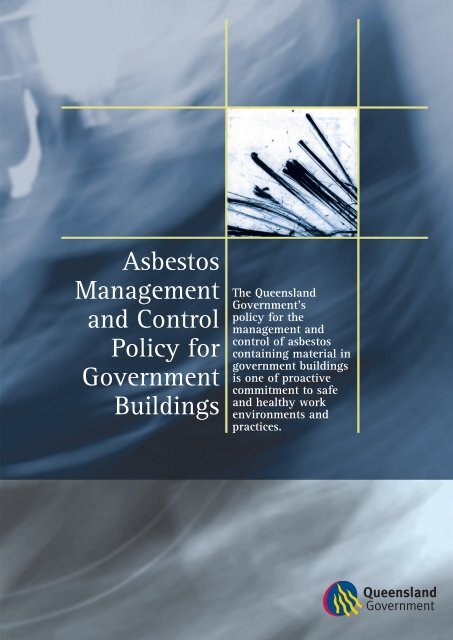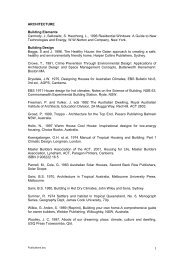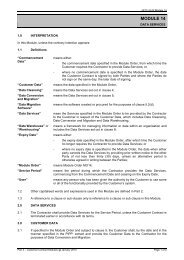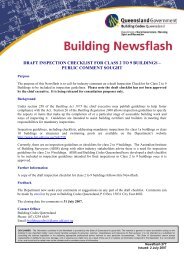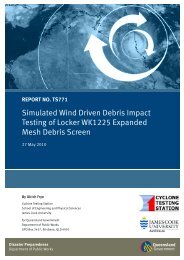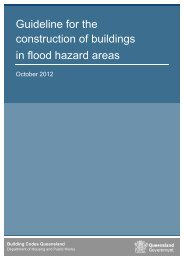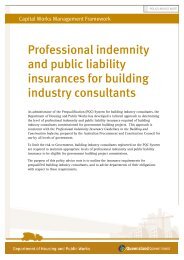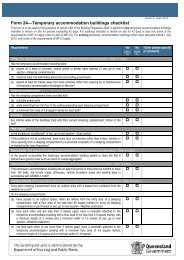Asbestos Management and Control Policy for Government Buildings
Asbestos Management and Control Policy for Government Buildings
Asbestos Management and Control Policy for Government Buildings
Create successful ePaper yourself
Turn your PDF publications into a flip-book with our unique Google optimized e-Paper software.
<strong>Asbestos</strong><br />
<strong>Management</strong><br />
<strong>and</strong> <strong>Control</strong><br />
<strong>Policy</strong> <strong>for</strong><br />
<strong>Government</strong><br />
<strong>Buildings</strong><br />
The Queensl<strong>and</strong><br />
<strong>Government</strong>’s<br />
policy <strong>for</strong> the<br />
management <strong>and</strong><br />
control of asbestos<br />
containing material in<br />
government buildings<br />
is one of proactive<br />
commitment to safe<br />
<strong>and</strong> healthy work<br />
environments <strong>and</strong><br />
practices.
ASBESTOS MANAGEMENT AND CONTROL POLICY FOR<br />
GOVERNMENT BUILDINGS<br />
Second Edition<br />
Queensl<strong>and</strong> Department of Public Works<br />
July 2011<br />
ISBN 978-1-921670-19-0<br />
This work is copyright. Apart from any use permitted under the Copyright Act 1968 (as amended),<br />
no part may be reproduced without written permission of the Director-General, Department of<br />
Public Works.<br />
For further in<strong>for</strong>mation, visit www.works.qld.gov.au<br />
Enquiries should be directed to:<br />
Executive Director<br />
Technical Services<br />
Building Services<br />
Department of Public Works<br />
GPO Box 2457<br />
BRISBANE Qld 4001
Contents<br />
Page<br />
Foreword<br />
ii<br />
Introduction<br />
What is asbestos 1<br />
When is asbestos hazardous to health 1<br />
<strong>Asbestos</strong> <strong>Management</strong> <strong>and</strong> <strong>Control</strong> <strong>Policy</strong><br />
<strong>Policy</strong> Statement 2<br />
<strong>Policy</strong> Objective 2<br />
Scope 2<br />
Principles 2<br />
<strong>Policy</strong> Implementation 3<br />
<strong>Asbestos</strong> <strong>Management</strong> <strong>and</strong> <strong>Control</strong> Strategy<br />
Why is there a need <strong>for</strong> a Strategy 4<br />
What is the objective of the Strategy 4<br />
Which assets are covered under the Strategy 4<br />
What is the <strong>Asbestos</strong> <strong>Management</strong> <strong>and</strong> <strong>Control</strong> Strategy 5<br />
What actions are required to implement the Strategy 5<br />
Who has responsibilities under the Strategy 7<br />
How is the Strategy managed 9<br />
How is the Strategy funded 10<br />
Attachments<br />
1. Definitions <strong>for</strong> the purposes of the <strong>Policy</strong> 11<br />
2. Relevant Legislation, Codes <strong>and</strong> Guidelines 14<br />
<strong>Asbestos</strong> <strong>Management</strong> <strong>and</strong> <strong>Control</strong> <strong>Policy</strong> <strong>for</strong> <strong>Government</strong> <strong>Buildings</strong><br />
i
Foreword<br />
I am pleased to introduce the <strong>Asbestos</strong> <strong>Management</strong> <strong>and</strong> <strong>Control</strong> <strong>Policy</strong> <strong>for</strong> <strong>Government</strong> <strong>Buildings</strong> (the <strong>Policy</strong>)<br />
<strong>for</strong> asbestos containing material in Queensl<strong>and</strong> <strong>Government</strong> buildings.<br />
Since the early 1990s, the Queensl<strong>and</strong> <strong>Government</strong>’s strategy <strong>for</strong> the management <strong>and</strong> control of asbestos<br />
containing material in its buildings has been one of proactive commitment to safe <strong>and</strong> healthy work<br />
environments <strong>and</strong> practices. It is based on the st<strong>and</strong>ards set by the National Occupational Health <strong>and</strong> Safety<br />
Commission <strong>and</strong> reflected in State legislation.<br />
Significant achievements <strong>and</strong> progress have been made in identifying <strong>and</strong> recording the presence of asbestos<br />
containing material in government buildings, removing the high-risk material <strong>and</strong> implementing appropriate<br />
strategies <strong>for</strong> the management of the material that remains.<br />
This momentum needs to continue. However, a change of focus is necessary in line with the requirements of<br />
the revised National Occupational Health <strong>and</strong> Safety Commission Codes of Practice, <strong>and</strong> the corresponding<br />
amendments to the Queensl<strong>and</strong> Workplace Health <strong>and</strong> Safety legislation.<br />
The <strong>Policy</strong> supports the ultimate goal of the Code of Practice <strong>for</strong> the <strong>Management</strong> <strong>and</strong> <strong>Control</strong> of <strong>Asbestos</strong><br />
in Workplaces <strong>for</strong> all workplaces to be free of asbestos containing material. The <strong>Policy</strong> recognises the<br />
<strong>Government</strong>’s responsibility as an employer, major building owner <strong>and</strong> service provider in relation to the<br />
management <strong>and</strong> control of such material. It provides a framework <strong>for</strong> ensuring it is managed consistently<br />
across departments, in a way that protects the health <strong>and</strong> well-being of workers, contractors <strong>and</strong> the<br />
community.<br />
The Department of Public Works will continue in its role as the Queensl<strong>and</strong> <strong>Government</strong>’s management<br />
authority <strong>for</strong> asbestos containing material in government buildings with responsibility <strong>for</strong> overseeing the<br />
implementation of the <strong>Policy</strong>.<br />
Natalie MacDonald<br />
Director-General<br />
Department of Public Works<br />
ii<br />
<strong>Asbestos</strong> <strong>Management</strong> <strong>and</strong> <strong>Control</strong> <strong>Policy</strong> <strong>for</strong> <strong>Government</strong> <strong>Buildings</strong>
Introduction<br />
What is asbestos<br />
<strong>Asbestos</strong> is a common term used to describe the fibrous <strong>for</strong>m of a group of naturally occurring mineral<br />
silicates belonging to the serpentine <strong>and</strong> amphibole groups of rock <strong>for</strong>ming minerals. The most common<br />
types of asbestos found in building materials are chrysotile (white asbestos), amosite (brown asbestos) <strong>and</strong><br />
crocidolite (blue asbestos).<br />
<strong>Asbestos</strong> was used widely in Australian buildings <strong>and</strong> structures between the 1940s <strong>and</strong> 1980s because of its<br />
durability, fire resistance <strong>and</strong> excellent insulating properties. Heightened public awareness of asbestos related<br />
diseases has increased public concern over the h<strong>and</strong>ling <strong>and</strong> ongoing management of asbestos containing<br />
material.<br />
When is asbestos hazardous to health<br />
<strong>Asbestos</strong> is not always an immediate hazard <strong>and</strong> does not present a risk to health when it is stable,<br />
encapsulated <strong>and</strong> contained in a bonded <strong>for</strong>m. It is only when asbestos containing material is disturbed, or<br />
damaged in a manner likely to cause the release of respirable asbestos fibres, that any potential health risk<br />
exists. When asbestos containing material is damaged or disturbed, it is possible <strong>for</strong> some fibres to become<br />
airborne. Inhalation of these fibres may cause significant health problems such as:<br />
• Malignant mesothelioma—a cancer of the outer covering of the lung (the pleura) or the<br />
abdominal cavity (the peritoneum). The latency period <strong>for</strong> mesothelioma is often 15 to 30<br />
years<br />
• <strong>Asbestos</strong>is—a <strong>for</strong>m of lung disease (pneumoconiosis) directly caused by inhaling asbestos<br />
fibres, causing a scarring (fibrosis) of the lung tissue decreasing the ability of the lungs to<br />
transfer oxygen to the blood. The latency period <strong>for</strong> asbestosis is generally between 15 <strong>and</strong><br />
25 years<br />
• Lung cancer—been shown to be caused by all types of asbestos. The latency period of<br />
the disease, from the first exposure to asbestos, ranges from 20 to 30 years. Lung cancer<br />
symptoms are rarely obvious until the disease has developed to an advanced stage.<br />
High levels of exposure to airborne fibres over a prolonged period of time increases the risk of asbestos<br />
related diseases. The use of power tools to cut, drill <strong>and</strong> s<strong>and</strong> bonded asbestos containing material or the<br />
inappropriate h<strong>and</strong>ling of friable material, are examples of actions likely to cause fibres to become airborne.<br />
<strong>Asbestos</strong> <strong>Management</strong> <strong>and</strong> <strong>Control</strong> <strong>Policy</strong> <strong>for</strong> <strong>Government</strong> <strong>Buildings</strong> 1
<strong>Asbestos</strong> <strong>Management</strong> <strong>and</strong> <strong>Control</strong> <strong>Policy</strong><br />
<strong>Policy</strong> Statement<br />
The Queensl<strong>and</strong> <strong>Government</strong> is committed to ensuring that asbestos containing material in government<br />
controlled buildings is managed <strong>and</strong> controlled to protect the health <strong>and</strong> well-being of workers, contractors<br />
<strong>and</strong> the community.<br />
<strong>Policy</strong> Objective<br />
The Queensl<strong>and</strong> <strong>Government</strong>’s long term objective is <strong>for</strong> all government controlled buildings to be free of<br />
asbestos containing material. This aim will be pursued through a risk management based strategy designed<br />
to safeguard those persons who occupy, service <strong>and</strong> visit government controlled buildings from exposure to<br />
respirable asbestos fibres.<br />
Scope<br />
The <strong>Policy</strong> applies to all Queensl<strong>and</strong> <strong>Government</strong> departments that have obligations to manage <strong>and</strong> control<br />
asbestos containing material in government controlled buildings (as defined in Attachment 1) which are<br />
workplaces. The <strong>Policy</strong> also applies to domestic premises (as defined in Attachment 1) to the extent detailed.<br />
The <strong>Policy</strong> does not apply to Statutory Bodies <strong>and</strong> <strong>Government</strong> Owned Corporations. These are expected<br />
to implement their own asbestos management <strong>and</strong> control policies to fulfil their legislative <strong>and</strong> broader<br />
community obligations.<br />
While the majority of asbestos containing material is likely to be found in buildings, departments should be<br />
aware that asbestos containing material may be found in other assets not covered under this <strong>Policy</strong>, such as<br />
vessels <strong>and</strong> vehicles. Appropriate management regimes should be implemented to ensure any associated risks<br />
are appropriately managed.<br />
Principles<br />
The <strong>Policy</strong> is underpinned by the following principles:<br />
• The <strong>Policy</strong> is consistent with <strong>and</strong> supports the requirements of the Queensl<strong>and</strong> Workplace<br />
Health <strong>and</strong> Safety legislation <strong>and</strong> National Codes of Practice in relation to the management,<br />
control <strong>and</strong> removal of asbestos containing material. It also supports other Queensl<strong>and</strong><br />
<strong>Government</strong> asset management policies including the Capital Works <strong>Management</strong><br />
Framework <strong>and</strong> the Maintenance <strong>Management</strong> Framework.<br />
• Departments will take all necessary steps to protect the health <strong>and</strong> safety of workers,<br />
contractors <strong>and</strong> the community from the risks associated with asbestos containing material<br />
within government controlled buildings.<br />
• The Department of Public Works is the Queensl<strong>and</strong> <strong>Government</strong>’s management authority<br />
<strong>for</strong> asbestos containing material in government controlled buildings (endorsed by Executive<br />
<strong>Government</strong> in 1993) <strong>and</strong> is responsible <strong>for</strong> overseeing the implementation of the <strong>Policy</strong>.<br />
• A risk management based approach will be adopted <strong>for</strong> the management <strong>and</strong> control of<br />
asbestos containing material.<br />
• Departments will be responsible <strong>for</strong> ensuring the removal of asbestos containing material<br />
is considered in conjunction with building renovation, refurbishment, demolition <strong>and</strong><br />
maintenance programs.<br />
• <strong>Buildings</strong> with asbestos containing material should not be purchased or leased <strong>for</strong><br />
occupancy unless all alternatives have been considered <strong>and</strong> an asbestos management plan<br />
has been developed to address the assessed risk.<br />
2 <strong>Asbestos</strong> <strong>Management</strong> <strong>and</strong> <strong>Control</strong> <strong>Policy</strong> <strong>for</strong> <strong>Government</strong> <strong>Buildings</strong>
• For government controlled buildings, departments will ensure required surveys are<br />
undertaken; site-specific asbestos management plans are maintained;<br />
<strong>and</strong> required in<strong>for</strong>mation is provided to the registers of asbestos containing material.<br />
• Registers will be maintained to record the presence, or presumed presence, of asbestos<br />
containing material within all government controlled buildings.<br />
• The Department of Public Works will report on departments’ management of asbestos<br />
containing material within their government controlled buildings.<br />
• Departments will consult with workers <strong>and</strong> their representatives, contractors <strong>and</strong> the<br />
community in relation to the management <strong>and</strong> control of asbestos containing material<br />
in all government controlled buildings.<br />
<strong>Policy</strong> Implementation<br />
The Strategy incorporated in this document has been developed to provide direction <strong>for</strong> giving effect to the<br />
<strong>Policy</strong> <strong>and</strong> achieving its objective.<br />
<strong>Asbestos</strong> <strong>Management</strong> <strong>and</strong> <strong>Control</strong> <strong>Policy</strong> <strong>for</strong> <strong>Government</strong> <strong>Buildings</strong> 3
<strong>Asbestos</strong> <strong>Management</strong> <strong>and</strong> <strong>Control</strong> Strategy<br />
Why is there a need <strong>for</strong> a Strategy<br />
In April 2005, the then National Occupational Health <strong>and</strong> Safety Commission (NOHSC) approved the release<br />
of a revised Code of Practice <strong>for</strong> the <strong>Management</strong> <strong>and</strong> <strong>Control</strong> of <strong>Asbestos</strong> in Workplaces. This Code <strong>and</strong> a<br />
revised NOHSC Code of Practice <strong>for</strong> the Safe Removal of <strong>Asbestos</strong> were endorsed by the Workplace Relations<br />
Ministerial Council in August 2005.<br />
The revised NOHSC Code has the ultimate goal of removing all asbestos containing material from workplaces,<br />
while at the same time providing guidance on managing asbestos containing material to prevent it from<br />
becoming a serious health risk.<br />
In response to the declaration of the National Codes of Practice <strong>and</strong> their endorsement by the Workplace<br />
Relations Ministerial Council, the Queensl<strong>and</strong> Workplace Health <strong>and</strong> Safety Act <strong>and</strong> Regulation were<br />
amended to give effect to the changes introduced.<br />
The initial <strong>Asbestos</strong> Strategic <strong>Management</strong> Program, approved by Executive <strong>Government</strong> in 1993, focussed<br />
on buildings maintained by the Department of Public Works <strong>and</strong> hospitals. It included the program of<br />
asbestos audits, preparation of Building <strong>Management</strong> Plans (now referred to as <strong>Asbestos</strong> <strong>Management</strong><br />
Plans) <strong>and</strong> the removal of all known friable asbestos containing material from buildings maintained by the<br />
Department of Public Works.<br />
The Strategy now needs to focus on the removal of any remaining friable asbestos containing material from<br />
non-Department of Public Works maintained buildings <strong>and</strong> the management <strong>and</strong> control of the lower risk<br />
asbestos containing material including, where necessary, removal of this material under a risk management<br />
based approach.<br />
This Strategy will assist in ensuring that the Queensl<strong>and</strong> <strong>Government</strong>, as a responsible employer, major<br />
building owner <strong>and</strong> service provider, continues to honour its responsibilities <strong>and</strong> obligations to its workers,<br />
contractors <strong>and</strong> the community, consistent with the relevant legislation, codes <strong>and</strong> guidelines (refer<br />
Attachment 2).<br />
What is the objective of the Strategy<br />
The objective of the Strategy is to provide a framework <strong>for</strong> directing departments on the management <strong>and</strong><br />
control <strong>and</strong> safe removal of asbestos containing material. This will assist in ensuring a consistent approach<br />
across departments <strong>and</strong> that initiatives <strong>and</strong> available funding are directed towards the achievement of the<br />
<strong>Policy</strong> objective.<br />
Which assets are covered under the Strategy<br />
This Strategy applies to government controlled buildings that are workplaces or domestic premises, as defined<br />
in Attachment 1. Domestic premises include residences used exclusively <strong>for</strong> government employee housing,<br />
as well as those residences owned by the Department of Communities <strong>and</strong> other departments that provide<br />
housing <strong>for</strong> members of the community. <strong>Buildings</strong> which serve the dual purpose of workplace <strong>and</strong> residence<br />
(e.g. a combined police station/residence), are regarded as workplaces <strong>for</strong> the purposes of the Strategy, not<br />
domestic premises.<br />
4 <strong>Asbestos</strong> <strong>Management</strong> <strong>and</strong> <strong>Control</strong> <strong>Policy</strong> <strong>for</strong> <strong>Government</strong> <strong>Buildings</strong>
What is the <strong>Asbestos</strong> <strong>Management</strong> <strong>and</strong> <strong>Control</strong> Strategy<br />
The Strategy is based on a risk management approach <strong>and</strong> involves:<br />
1. identification <strong>and</strong> recording of asbestos containing material<br />
2. assessment of the risks posed by the asbestos containing material identified<br />
3. management of in situ asbestos containing material based on its assessed level of risk<br />
4. removal of asbestos containing material based on its assessed level of risk<br />
5. development <strong>and</strong> maintenance of effective consultation frameworks <strong>and</strong> awareness training<br />
programs.<br />
What actions are required to implement the Strategy<br />
<strong>Buildings</strong> that are workplaces<br />
In relation to buildings that are workplaces, the Strategy will be implemented through the introduction or<br />
continuation of the following actions:<br />
Identification <strong>and</strong> recording of asbestos containing material<br />
• Development of registers of asbestos containing material in <strong>Government</strong> workplaces<br />
<strong>and</strong> government employee housing with online internet access to ensure ready access<br />
to reliable <strong>and</strong> current data. Note that a separate register will be maintained by the<br />
Department of Communities <strong>for</strong> domestic premises under its control.<br />
• Undertaking surveys <strong>and</strong> recording the results in the registers of asbestos containing<br />
material.<br />
Assessment of the risk posed by the asbestos containing material identified<br />
• Undertaking surveys of in situ asbestos containing material <strong>and</strong> assessing the risk<br />
associated with that material.<br />
• Ensuring that records relating to the removal <strong>and</strong> disposal of asbestos containing material<br />
are maintained according to the provisions of the Public Records Act 2002, <strong>and</strong> the<br />
requirements of the NOHSC National Codes of Practice <strong>for</strong> the <strong>Management</strong> <strong>and</strong> <strong>Control</strong> of<br />
<strong>Asbestos</strong> in Workplaces <strong>and</strong> the Safe Removal of <strong>Asbestos</strong>.<br />
<strong>Management</strong> of in situ asbestos containing material based on its assessed level of risk<br />
• Development <strong>and</strong> maintenance of <strong>Asbestos</strong> <strong>Management</strong> Plans.<br />
• Development of protocols <strong>and</strong> guidelines <strong>for</strong> the management of in situ asbestos<br />
containing material including the effective use of <strong>Asbestos</strong> <strong>Management</strong> Plans, work area<br />
access permits, signage <strong>and</strong> labelling.<br />
• Maintenance of the registers of asbestos containing material to record all changes in the<br />
status of confirmed or presumed asbestos containing material <strong>and</strong> works undertaken in<br />
areas where asbestos containing material has been confirmed, or is presumed, to exist.<br />
• Development <strong>and</strong> implementation of education <strong>and</strong> training programs on asbestos<br />
management <strong>and</strong> control.<br />
• Continued support <strong>for</strong> research into asbestos issues <strong>and</strong> promulgation of that research<br />
across departments e.g. research that assists in assessing <strong>and</strong> monitoring the health <strong>and</strong><br />
environmental risks of asbestos containing material is particularly relevant.<br />
<strong>Asbestos</strong> <strong>Management</strong> <strong>and</strong> <strong>Control</strong> <strong>Policy</strong> <strong>for</strong> <strong>Government</strong> <strong>Buildings</strong> 5
Removal of asbestos containing material based on its assessed level of risk<br />
• Removal of any identified high risk <strong>and</strong>/or friable asbestos containing material in a poor<br />
condition as an immediate priority.<br />
• Development <strong>and</strong> implementation of programs, where necessary, <strong>for</strong> the removal of asbestos<br />
containing material where a risk assessment indicates the need <strong>for</strong> removal.<br />
• Removal of asbestos containing material, wherever feasible, during renovation, refurbishment,<br />
demolition <strong>and</strong> maintenance works instead of enclosure, encapsulation or sealing.<br />
Development <strong>and</strong> maintenance of effective consultation framework <strong>and</strong><br />
awareness training programs<br />
• Development of a framework <strong>for</strong> full <strong>and</strong> open consultation with workers, their<br />
representatives <strong>and</strong> the community on matters related to asbestos containing material.<br />
• Development <strong>and</strong> implementation of measures to ensure that workers, contractors <strong>and</strong> the<br />
community are aware of the risks associated with asbestos containing material <strong>and</strong> their<br />
responsibilities as part of those measures.<br />
Domestic premises<br />
In extending the provisions of the <strong>Policy</strong> <strong>and</strong> Strategy to domestic premises, it is acknowledged that almost<br />
all asbestos containing material in those premises will be in the <strong>for</strong>m of bonded, painted asbestos cement<br />
sheeting such as wall <strong>and</strong> ceiling linings. These pose a negligible risk to health if maintained in a good<br />
condition <strong>and</strong> not disturbed e.g. drilled, cut or s<strong>and</strong>ed in a manner that is likely to cause the release<br />
of respirable asbestos fibres.<br />
In relation to buildings that are domestic premises, the Strategy will be implemented through the following<br />
measures:<br />
Identification <strong>and</strong> recording of asbestos containing material<br />
• Identification of domestic premises in which the presence of asbestos containing material<br />
has been confirmed or is presumed.<br />
• Recording of domestic premises so identified in a register of asbestos containing material.<br />
Note that the Department of Communities will maintain a separate register <strong>for</strong> the<br />
recording of domestic premises it controls.<br />
• Ensuring that records relating to the removal <strong>and</strong> disposal of asbestos containing material<br />
are maintained according to the provisions of the Public Records Act 2002, <strong>and</strong> the<br />
requirements of the NOHSC National Codes of Practice <strong>for</strong> the <strong>Management</strong> <strong>and</strong> <strong>Control</strong> of<br />
<strong>Asbestos</strong> in Workplaces <strong>and</strong> the Safe Removal of <strong>Asbestos</strong>.<br />
<strong>Management</strong> of in situ asbestos containing material based on its assessed level of risk<br />
• Provision of guidance material to occupants of premises presumed or confirmed as<br />
containing in situ asbestos containing material on precautions to be taken if the material<br />
is disturbed.<br />
• Provision of notices within each residence to in<strong>for</strong>m contractors of the confirmed or<br />
presumed presence of in situ asbestos containing material (e.g. signage in the electrical<br />
meter box <strong>and</strong> on the back of the pantry door or on the back of the door under the<br />
kitchen sink).<br />
6 <strong>Asbestos</strong> <strong>Management</strong> <strong>and</strong> <strong>Control</strong> <strong>Policy</strong> <strong>for</strong> <strong>Government</strong> <strong>Buildings</strong>
Removal of asbestos containing material based on its assessed level of risk<br />
• The removal of any identified high risk <strong>and</strong>/or friable asbestos containing material in a<br />
poor condition as an immediate priority.<br />
• Development <strong>and</strong> implementation of programs, where necessary, <strong>for</strong> the removal of<br />
asbestos containing material where a risk assessment indicates the need <strong>for</strong> removal.<br />
• Removal of asbestos containing material, wherever feasible, during renovation, refurbishment,<br />
demolition <strong>and</strong> maintenance works instead of enclosure, encapsulation or sealing.<br />
Who has responsibilities under the Strategy<br />
<strong>Government</strong><br />
The Queensl<strong>and</strong> <strong>Government</strong>, in general terms, has a responsibility to protect the health <strong>and</strong> well-being of its<br />
workers, contractors <strong>and</strong> the community occupying, servicing <strong>and</strong> visiting government controlled buildings.<br />
As part of this responsibility, it will provide leadership <strong>and</strong> support <strong>for</strong> the implementation of the Strategy.<br />
Department of Public Works<br />
The Department of Public Works, in its role as management authority, will oversee <strong>and</strong> support the<br />
implementation of the <strong>Policy</strong> <strong>and</strong> the Strategy. It will exercise these responsibilities by:<br />
• promoting the <strong>Policy</strong> across departments<br />
• conducting periodic reviews of the <strong>Policy</strong> <strong>and</strong> the Strategy developed <strong>for</strong> its implementation<br />
• developing operational guidelines <strong>for</strong> the management <strong>and</strong> control of asbestos containing material<br />
• developing <strong>and</strong> implementing a framework <strong>for</strong> effective consultation <strong>and</strong> communication<br />
on the <strong>Policy</strong> <strong>and</strong> Strategy<br />
• undertaking regular surveys of asbestos containing material upon request from departments<br />
• managing the development <strong>and</strong> delivery of specific programs <strong>for</strong> the removal of asbestos<br />
containing material, where required<br />
• developing <strong>and</strong> maintaining registers of asbestos containing material <strong>for</strong> buildings <strong>and</strong><br />
domestic premises (other than domestic premises controlled by the Department of Communities),<br />
including the development of protocols to ensure the veracity <strong>and</strong> whole-of-<strong>Government</strong><br />
coverage of the records<br />
• providing assistance to all departments in terms of in<strong>for</strong>mation, technical advice <strong>and</strong><br />
removal expertise<br />
• satisfying departments’ needs <strong>for</strong> education <strong>and</strong> awareness training programs<br />
• providing support <strong>for</strong> relevant research programs<br />
• reporting on departments’ management of asbestos containing material within their<br />
government controlled buildings.<br />
<strong>Asbestos</strong> <strong>Management</strong> <strong>and</strong> <strong>Control</strong> <strong>Policy</strong> <strong>for</strong> <strong>Government</strong> <strong>Buildings</strong> 7
<strong>Government</strong> Departments<br />
Departments have a responsibility to provide <strong>and</strong> maintain safe <strong>and</strong> healthy work environments <strong>and</strong> related<br />
work practices.<br />
In relation to asbestos containing material, departments will, with respect to the government controlled<br />
buildings <strong>for</strong> which they are responsible, exercise this responsibility by:<br />
• ensuring compliance with relevant State legislation, whole-of-<strong>Government</strong> policies,<br />
guidelines <strong>and</strong> National Codes of Practice in relation to the management <strong>and</strong> control of<br />
asbestos containing material including, but not limited to, the Code of Practice <strong>for</strong> the<br />
<strong>Management</strong> <strong>and</strong> <strong>Control</strong> of <strong>Asbestos</strong> in Workplaces [NOHSC: 2018 (2005)] <strong>and</strong> the Code of<br />
Practice <strong>for</strong> the Safe Removal of <strong>Asbestos</strong> 2nd Edition [NOHSC: 2002 (2005)]<br />
• implementing consistent policies <strong>and</strong> procedures <strong>for</strong> the management <strong>and</strong> control of<br />
asbestos containing material<br />
• establishing <strong>and</strong> maintaining <strong>Asbestos</strong> <strong>Management</strong> Plans <strong>for</strong> their facilities<br />
• identifying all asbestos containing material by location, type, condition <strong>and</strong> risk in<br />
workplaces<br />
• arranging regular surveys <strong>and</strong> risk assessments of asbestos containing material<br />
• arranging <strong>for</strong> the planned removal of asbestos containing material including removals to<br />
be undertaken in conjunction with building renovation, refurbishment, demolition <strong>and</strong><br />
maintenance programs, wherever feasible<br />
• controlling all work associated with asbestos containing material within buildings through<br />
a work area access permit process or other appropriate mechanism<br />
• ensuring all required signage <strong>and</strong> labelling is installed <strong>and</strong> maintained<br />
• providing complete <strong>and</strong> timely in<strong>for</strong>mation to the Department of Public Works to maintain<br />
the accuracy of the register of asbestos containing material<br />
• maintaining records <strong>and</strong>, in particular, all in<strong>for</strong>mation that may be required <strong>for</strong> all potential<br />
future compensation claims<br />
• ensuring any non building-related equipment, confirmed or presumed as having asbestos<br />
containing material is not introduced, utilised or retained. A strategy <strong>for</strong> management,<br />
disposal or replacement should be in place to cover existing asbestos containing material in<br />
equipment where immediate disposal is impractical (i.e. <strong>for</strong> essential equipment where there<br />
is no asbestos free alternative)<br />
• establishing consultative arrangements with workers <strong>and</strong> their representatives<br />
• ensuring the delivery of appropriate education <strong>and</strong> awareness programs<br />
• ensuring that their contractors comply with legislative requirements <strong>and</strong> follow the<br />
requirements of <strong>Asbestos</strong> <strong>Management</strong> Plans<br />
• providing relevant in<strong>for</strong>mation to the Department of Public Works <strong>for</strong> reporting purposes.<br />
In the case of buildings to be purchased or leased, departments are to ensure that buildings with asbestos<br />
containing material are not purchased or leased <strong>for</strong> occupancy unless all alternatives have been considered<br />
<strong>and</strong> an <strong>Asbestos</strong> <strong>Management</strong> Plan has been developed to manage the assessed risk.<br />
8 <strong>Asbestos</strong> <strong>Management</strong> <strong>and</strong> <strong>Control</strong> <strong>Policy</strong> <strong>for</strong> <strong>Government</strong> <strong>Buildings</strong>
Workers<br />
Workers have a Statutory Obligation under the Workplace Health <strong>and</strong> Safety Act 1995 to:<br />
• comply with workplace health <strong>and</strong> safety instructions<br />
• use personal protective equipment if it is provided <strong>and</strong> if proper instructions are given <strong>for</strong> its use<br />
• not wilfully or recklessly interfere with or misuse anything provided <strong>for</strong> workplace health <strong>and</strong> safety<br />
• not wilfully place at risk the workplace health <strong>and</strong> safety of any person or to wilfully injure<br />
themselves.<br />
Contractors<br />
Contractors have a responsibility to ensure any work that will disturb asbestos containing material (e.g.<br />
removal, maintenance work or the installation/alteration of services) is undertaken in accordance with all<br />
relevant Codes of Practice, legislative requirements <strong>and</strong> issued instructions.<br />
In particular, the engagement of contractors will require the contractor to:<br />
• ascertain whether asbestos containing material is present or is presumed to be present in<br />
the work area<br />
• obtain a work area access permit be<strong>for</strong>e commencing any work in an area where asbestos<br />
containing material is present or presumed to be present <strong>and</strong> may be disturbed during the<br />
course of the work<br />
• ensure the work per<strong>for</strong>med is accurately described on the work area access permit<br />
• employ prescribed work methods <strong>and</strong> ensure that workers have received instruction <strong>and</strong><br />
training on working safely with asbestos containing material.<br />
How is the Strategy managed<br />
Senior Officers’ Steering Committee<br />
The implementation of the Strategy requires interdepartmental strategic oversight to ensure the best outcomes<br />
<strong>for</strong> <strong>Government</strong> <strong>and</strong> individual departments. This will be provided through the established Senior Officers’<br />
Steering Committee whose role will incorporate the following activities:<br />
• review <strong>and</strong> advise on the effectiveness <strong>and</strong> objective of the <strong>Policy</strong> <strong>and</strong> Strategy <strong>and</strong> their<br />
responsiveness to government <strong>and</strong> community expectations<br />
• review the <strong>for</strong>mulation of funding submissions <strong>for</strong> whole-of-<strong>Government</strong> programs <strong>and</strong>, as<br />
required, review <strong>and</strong> advise on specific departmental programs<br />
• consider <strong>and</strong> advise on the rate of progress with approved whole-of-<strong>Government</strong> programs<br />
<strong>and</strong> any significant issues/incidents arising.<br />
The Committee includes representation from the following departments:<br />
• Department of Public Works (Chair)<br />
• Department of the Premier <strong>and</strong> Cabinet<br />
• Queensl<strong>and</strong> Treasury<br />
• Department of Justice <strong>and</strong> Attorney-General<br />
• Major building asset holding departments.<br />
<strong>Management</strong> Authority<br />
The Department of Public Works is the appointed management authority <strong>for</strong> the <strong>Policy</strong> <strong>and</strong> Strategy.<br />
<strong>Asbestos</strong> <strong>Management</strong> <strong>and</strong> <strong>Control</strong> <strong>Policy</strong> <strong>for</strong> <strong>Government</strong> <strong>Buildings</strong> 9
How is the Strategy funded<br />
<strong>Management</strong> <strong>and</strong> <strong>Control</strong><br />
The Department of Public Works will secure funding <strong>for</strong> on-going maintenance of a register of asbestos<br />
containing material (except public housing which is maintained by the Department of Communities).<br />
<strong>Management</strong> <strong>and</strong> control of asbestos containing material in accordance with the <strong>Policy</strong> is the responsibility<br />
of departments that control buildings with asbestos containing material.<br />
Removal<br />
The removal of asbestos containing material in accordance with the <strong>Policy</strong> is the responsibility of<br />
departments that control buildings with asbestos containing material.<br />
Funding <strong>for</strong> the removal of asbestos containing material undertaken in conjunction with refurbishment,<br />
renovation <strong>and</strong> planned maintenance projects will need to be secured by the controlling department as part<br />
of the funding <strong>for</strong> the total project.<br />
10 <strong>Asbestos</strong> <strong>Management</strong> <strong>and</strong> <strong>Control</strong> <strong>Policy</strong> <strong>for</strong> <strong>Government</strong> <strong>Buildings</strong>
Attachment 1<br />
Definitions <strong>for</strong> the purpose of the <strong>Policy</strong><br />
asbestos containing material (ACM)<br />
means any material, object, product or debris that contains<br />
asbestos. 1<br />
asbestos register<br />
means the register maintained by the Department of Public<br />
Works (or the Department of Communities in relation to<br />
domestic premises which it controls) used to record the presence,<br />
or presumed presence, of asbestos containing material <strong>and</strong><br />
changes made thereto.<br />
bonded asbestos containing material<br />
means asbestos containing material containing a bonding<br />
compound rein<strong>for</strong>ced with asbestos fibres. 1<br />
building<br />
means any roofed structure, the site on which the building is<br />
located, fixed plant <strong>and</strong> equipment items that are associated<br />
with buildings (e.g. air conditioning systems <strong>and</strong> generators),<br />
site infrastructure (e.g. fencing, water supply <strong>and</strong> drainage) <strong>and</strong><br />
special purpose facilities (e.g. swimming pools).<br />
community<br />
means those members of the public that visit or use government<br />
buildings.<br />
contractor<br />
means any person who carries out maintenance, new<br />
construction, renovation/refurbishment or demolition activities<br />
in relation to a building.<br />
department means a department of government as defined under Section 8<br />
of the Financial Accountability Act 2009.<br />
domestic premises<br />
means buildings that are provided as residential accommodation<br />
by the State, used solely <strong>for</strong> residential purposes. Domestic<br />
premises include residences used exclusively <strong>for</strong> government<br />
employee housing as well as those residences owned by the<br />
Department of Communities <strong>and</strong> other departments that provide<br />
housing <strong>for</strong> members of the community. <strong>Buildings</strong> which serve<br />
the dual purpose of workplace <strong>and</strong> residence (e.g. a combined<br />
police station/residence), are regarded as workplaces <strong>for</strong> the<br />
purposes of the <strong>Policy</strong> <strong>and</strong> are not domestic premises.<br />
friable asbestos containing material<br />
means asbestos containing material that, when dry, is or may<br />
become crumbled, pulverised or reduced to powder by h<strong>and</strong><br />
pressure. 1<br />
<strong>Asbestos</strong> <strong>Management</strong> <strong>and</strong> <strong>Control</strong> <strong>Policy</strong> <strong>for</strong> <strong>Government</strong> <strong>Buildings</strong> 11
government controlled buildings<br />
means:<br />
(a) buildings that are owned by the State which are workplaces<br />
in respect of which the State has a legal obligation to<br />
manage <strong>and</strong> control asbestos containing material; <strong>and</strong><br />
(b) buildings that are leased to or from the State which are<br />
workplaces where the State has a legal obligation to manage<br />
<strong>and</strong> control asbestos containing material; <strong>and</strong><br />
(c) any other building which is a workplace in respect of which<br />
the State has a legal obligation to manage <strong>and</strong> control<br />
asbestos containing material; <strong>and</strong><br />
(d) includes buildings in respect of which the State is the ‘owner’<br />
of the building under the Workplace Health <strong>and</strong> Safety Act<br />
1995 3 ; <strong>and</strong><br />
(e) includes domestic premises as defined in this <strong>Policy</strong>.<br />
<strong>Government</strong> Owned Corporation<br />
means a government entity as defined in s.5 of the <strong>Government</strong><br />
Owned Corporations Act 1993.<br />
hazard<br />
means any matter, thing, process or practice that may cause<br />
death, injury, illness or disease. 2<br />
in situ means fixed or installed in its original position. 2<br />
management <strong>and</strong> control<br />
means the identification, ongoing inspection, maintenance of<br />
records, management in situ <strong>and</strong> progressive removal of asbestos<br />
containing material.<br />
NOHSC<br />
National Occupational Health <strong>and</strong> Safety Commission (of<br />
Australia) 2 (now SafeWork Australia since November 2009)<br />
non building-related equipment<br />
typically such items are, or <strong>for</strong>m part of, business equipment<br />
as distinct from engineering services plant <strong>and</strong> equipment (e.g.<br />
ovens, fire blankets, portable hot plates).<br />
residence<br />
includes detached houses, units, apartments <strong>and</strong> any other<br />
building provided as a dwelling.<br />
respirable asbestos fibre<br />
means a fibre of asbestos small enough to penetrate into the gas<br />
exchange regions of the lungs. Respirable asbestos fibres are<br />
technically defined as fibres that are less than 3 μm wide, more<br />
than 5 μm in length <strong>and</strong> have a length to width ratio of more<br />
than 3 to 1.<br />
risk means the likelihood of a hazard causing harm to a person. 2<br />
12 <strong>Asbestos</strong> <strong>Management</strong> <strong>and</strong> <strong>Control</strong> <strong>Policy</strong> <strong>for</strong> <strong>Government</strong> <strong>Buildings</strong>
statutory body<br />
means an entity as defined under s.9 of the Financial<br />
Accountability Act 2009.<br />
work<br />
means any activity, physical or mental, carried out in the course<br />
of a business, industry, commerce, an occupation or profession. 2<br />
work area access permit<br />
means the written authorisation issued by the person with<br />
control of the premises, granting access to a designated area<br />
which is known to contain, or is presumed to contain, asbestos<br />
containing material <strong>for</strong> the purpose of carrying out work.<br />
worker<br />
means an employee within a department.<br />
workplace means any place where a person works. 2<br />
Note: For the purpose of this <strong>Policy</strong>, place means any<br />
government controlled building which is used <strong>for</strong> work related<br />
activities.<br />
It excludes domestic premises.<br />
1 Queensl<strong>and</strong> Workplace Health <strong>and</strong> Safety Act <strong>and</strong> Regulation<br />
2 Code of Practice <strong>for</strong> the <strong>Management</strong> <strong>and</strong> <strong>Control</strong> of <strong>Asbestos</strong> in Workplaces [NOHSC: 2018(2005)]<br />
3 The definition of “owner” in the Workplace Health <strong>and</strong> Safety Act 1995, Schedule 3, is as follows:<br />
“owner means a person who holds legal title to a thing, structure or place, or part of a structure or place, <strong>and</strong> includes—<br />
(a)<br />
(b)<br />
a person who has control of a thing, structure or place; <strong>and</strong><br />
a person who manages a structure or place, or part of a structure or place, as agent <strong>for</strong>—<br />
(i) a person who holds legal title to the structure or place; or<br />
(ii) a person mentioned in paragraph (a); <strong>and</strong><br />
(c)<br />
(d)<br />
(e)<br />
(f)<br />
(g)<br />
(h)<br />
a person from whom a thing, structure or place, or part of a structure or place, was<br />
seized, unless the chief executive is aware of its actual owner; <strong>and</strong><br />
a mortgagee in possession; <strong>and</strong><br />
a lessee; <strong>and</strong><br />
a licensee; <strong>and</strong><br />
a trustee; <strong>and</strong><br />
a company administrator, receiver, receiver <strong>and</strong> manager or liquidator.”<br />
<strong>Asbestos</strong> <strong>Management</strong> <strong>and</strong> <strong>Control</strong> <strong>Policy</strong> <strong>for</strong> <strong>Government</strong> <strong>Buildings</strong> 13
Attachment 2<br />
Relevant Legislation, Codes <strong>and</strong> Guidelines<br />
• (Queensl<strong>and</strong>) Environmental Protection Act 1994<br />
• (Queensl<strong>and</strong>) Environmental Protection Regulation 2008<br />
• (Queensl<strong>and</strong>) Financial Accountability Act 2009<br />
• (Queensl<strong>and</strong>) <strong>Government</strong> Owned Corporations Act 1993<br />
• (Queensl<strong>and</strong>) Public Records Act 2002<br />
• (Queensl<strong>and</strong>) Work Health <strong>and</strong> Safety Act 2011<br />
• (Queensl<strong>and</strong>) Workplace Health <strong>and</strong> Safety Act 1995<br />
• (Queensl<strong>and</strong>) Workplace Health <strong>and</strong> Safety Regulation 2008<br />
• Code of Practice <strong>for</strong> the Safe Removal of <strong>Asbestos</strong> 2nd Edition [NOHSC: 2002 (2005)]<br />
• Code of Practice <strong>for</strong> the <strong>Management</strong> <strong>and</strong> <strong>Control</strong> of <strong>Asbestos</strong> in Workplaces [NOHSC: 2018<br />
(2005)]<br />
• Guidance Note on the Membrane Filter Method <strong>for</strong> Estimating Air Borne <strong>Asbestos</strong> Fibres,<br />
2nd Edition [NOHSC: 3003 (2005)]<br />
• (Queensl<strong>and</strong> <strong>Government</strong>) Capital Works <strong>Management</strong> Framework<br />
• (Queensl<strong>and</strong> <strong>Government</strong>) Maintenance <strong>Management</strong> Framework<br />
14 <strong>Asbestos</strong> <strong>Management</strong> <strong>and</strong> <strong>Control</strong> <strong>Policy</strong> <strong>for</strong> <strong>Government</strong> <strong>Buildings</strong>


